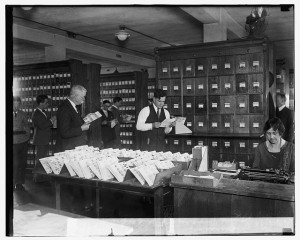What makes television shows like Bones, Criminal Minds, CSI, Law and Order, and NCIS so popular? Is it the intriguing plots and stories? I tend to think we love these shows because of the cool science and state of the art technology employed by the characters to catch criminals. If I weren’t a librarian, I would like to work in a laboratory helping out the crime scene investigators.
We have certainly come a long way since the pioneering work of Sir Francis Galton’s 1892 Finger Prints, which presented the ‘proof’ that fingerprints offer a unique identification, and Dr. Karl Landsteiner’s discovery in 1900 of different categories of blood groups (types), for which he won the 1930 Nobel Prize in Physiology/Medicine. Today’s forensic sciences include DNA typing, 3-D imaging technology, gas chromatography, and mass spectrometry.
Motivated by our researcher’s interests, I created a Forensic Science guide to help them learn more about the variety of sciences used to solve criminal, and sometimes civil, cases. This guide provides a plethora of information, such as examples of subject headings to use when searching the Library’s online catalog, specialized titles that focus on specific branches of science employed in solving criminal cases, and which abstracting and indexing (databases) to use when searching for articles related to forensic science. Books on the history of forensic science are also listed on this guide. One of the earliest examples of the use of science in matters of law (forensics) is the Hsi Yuan (Yeuan) Lu or Instructions to Coroners from China, which was published sometime around 1250 AD. There are even titles on forensic science experiments for the young scientist and career guidance for those pursuing a job in the profession. If that isn’t enough, there are sections dedicated to additional sources for information, namely a listing of government and associations who deal with forensic science, and a selection of Internet resources that will point you to further information, such as statistics and reports.



April 11, 2011 at 9:21 am
Finding A Single Criminal DNA,
Yet Silencing Genocides
Now a days…
All what was discovered is never enough
To diagnose…depress…teach the criminals
(From finger prints till recently discovered DNA)
We can still hear from every place
Many cruel types of genocides
Since millenniums breathe ‘gene-cide’ :
Defined by lawyer Rafael Lemkin (1900-1959),
After He understood and defined a hard phrase
He determined to convince to make it ‘A Law’;
For later that United Nation…
Signed and sited to every sight…
The criminal genes still
Faithlessly growing
Like a green trees
With scimitarated-leaves.
After they slay innocents
Governments spend millions
Of tax payers money
To find who did it and why !
Still answers are unanswered
Still it stay deep and beneath…
Till this day many genocides
Are unrecognized…by political criminals.
Thus…We need to find the gene
Which gave and gives births to slayers
Who are still breathing
Joyful life…between us.
As a scientist, a pediatrician, a mother
We need to modify…vanish…end the bad genes
So none of our cohorts heed
A killing word… difficult to ignore yet exhale…
Word as the Genocide…unfair-undear
To every kind of human race…
Worse than the word slavery…slaves
As slaves are alive,
Can breed, can dine and dance…!
Sylva-MD-Poetry
(A poetic soul shined from genocides)
Remember: April 24,1915
April 13, 2011 at 5:11 pm
My great grandfather was Dr. Harold Cummins a professor at Tulane University, was a pioneer in dermatoglyphics (scientific study of fingerprints).
http://www.tulane.edu/~matas/historical/medschool/doctors/cummins.htm